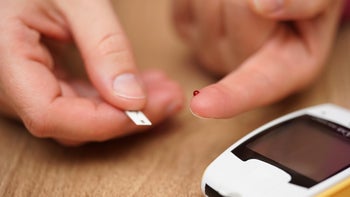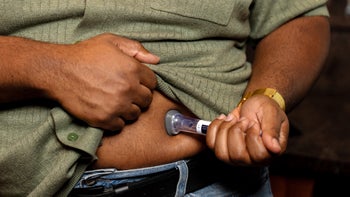
A1C Tests: Do You Need One, and How Often Should You Test?
Key takeaways:
A hemoglobin A1C test measures the average amount of glucose (sugar) in your blood over the past 2 to 3 months.
An A1C test is useful for monitoring how well treatment is working in people with diabetes.
An A1C is also a good way to check for diabetes in people who don’t have a diagnosis of diabetes. Consider getting a baseline A1C if you’re 35 or older, you have a high risk for diabetes, or you have symptoms of diabetes.
In the U.S., 1 in 10 people have diabetes. And 1 in 5 people don’t know they have it. These are significant numbers, and they may make you wonder if you might have diabetes. Fortunately, if you’re thinking about getting screened, there’s a quick and easy blood test to consider — hemoglobin A1C (HbA1C or A1C).
An A1C blood test estimates the level of glucose (sugar) in your blood over the last 2 to 3 months. It’s different from a blood glucose test or a finger-stick test, which can only tell you what your blood glucose level is at the moment of testing.
A1C testing has a few different uses. For people with diabetes, regular A1C testing monitors how well a diabetes treatment plan is working. But A1C is also useful for diagnosing diabetes and prediabetes.
Save on popular GLP-1 Agonists
Take control of your health. With GoodRx, you may be eligible to save even more on popular treatments.

Should you get an A1C test? The answer is “yes” if you’re at risk of diabetes or you have symptoms of diabetes. That’s because diabetes is a treatable condition. And the earlier you can diagnose it, the better.
How does an A1C test work?
Hemoglobin A1C measures glycosylated hemoglobin, or Hb A1C. That’s the part of the hemoglobin molecule that attaches to glucose.
But let’s back up a little. When you eat carbohydrates, these get broken down in the gut into glucose. Glucose is the body’s main source of energy. It gets absorbed into the bloodstream to fuel cells and organs around the body.
In the blood, glucose attaches to hemoglobin (the part of red blood cells that contain oxygen and iron). Glycosylated hemoglobin is the combination of glucose and hemoglobin, and that’s what the A1C blood test measures.
So, the higher your blood glucose levels are, the higher your hemoglobin A1C level will be. And because a red blood cell lives for 3 to 4 months, an A1C level gives an average blood glucose level over a similar period of time. This long-term view of your blood sugar level is a big advantage of A1C testing.
Who should get an A1C blood test?
Anyone with prediabetes or diabetes should get regular A1C testing. And anyone at risk of prediabetes or diabetes should get tested too.
This testing is important because estimates show that 1 in 10 people have diabetes, and as many as 1 in 3 have prediabetes. Most people with prediabetes don’t know they have it, and 1 in 5 people with diabetes also don’t know they have it. That’s a whole lot of people who should get an A1C test.
Here’s the thing: You can still have prediabetes even if you don’t have symptoms. And it can be hard to recognize the signs of diabetes. That’s why the American Diabetes Association (ADA) recommends A1C screening if you:
Are over the age of 35
Have a parent or sibling with diabetes
Fall into the category of overweight
Are physically active fewer than 3 times a week
Have certain racial/ethnic backgrounds
Have symptoms of diabetes — like increased thirst, frequent urination, and blurry vision
If you’re wondering whether you’re at risk for diabetes, this 60-second ADA risk test is a good place to start.
How often should you get an A1C test?
Your healthcare provider will let you know how often you should have A1C testing. This can vary person to person. Here are the general guidelines if you have:
Normal results (with risk factors): You’ll retest every 3 years.
Prediabetes: You’ll get A1C testing every 1 to 2 years.
Diabetes: You’ll get A1C testing at least twice a year.
How do you prepare for an A1C test?
There isn’t anything special to do before getting an A1C test. Unlike other labs, such as a fasting glucose or oral glucose tolerance tests, you do not need to stop eating or drinking before this blood test.
How long does it take to get results from an A1C test?
If you go to a lab for a blood draw, your A1C results will usually be available within a few days.
Some healthcare providers have an A1C machine in their office. This is known as “point-of-care” testing. These machines can give you an A1C result during your appointment. It’s convenient, but it’s not accurate enough for diagnosis. Point-of-care testing should only be used for monitoring people with diabetes who already have a treatment plan.
Can you test A1C levels at home?
Yes, you can test your A1C level at home. Research suggests that A1C home tests provide accurate results. There are a number of mail-in options. And there are also A1C self-check monitors that are similar to a glucometer (glucose meter).
But in some cases, home testing may not be right for you. Consider the following before you spend money on an at-home A1C test:
Cost: There’s a range of costs, so be sure to compare your options.
Insurance coverage: Insurance doesn’t cover most home test kits, but you can use your flexible spending account (FSA) or health saving account (HSA) funds to pay for some options.
Ease of use: Most require an online account to activate the test and receive results. But some allow you to simply call a number for results.
Results: It can take between 1 day and 3 weeks to get mailed results from an A1C test kit.
Support: Some options offer customer product support, if needed.
How accurate are A1C tests?
Nowadays they’re quite accurate. In the past, results varied a lot and depended on the machine that checked your blood sample. But, in recent years, a strict quality control program — The National Glycohemoglobin Standardization Program — standardized more than 99% of the A1C tests in the U.S. That’s huge, and it means that your A1C should be pretty similar wherever you get it tested.
The A1C isn’t a perfect test, but it has a few important advantages over other diabetes tests. First, it’s pretty consistent. It’s also convenient. It does not require fasting, special timing, or any kind of other preparation. That’s why experts consider it the “gold-standard test” for diagnosing and monitoring diabetes.
As mentioned above, the exception to this is point-of-care testing. While these tests are fairly accurate, they should be used only for monitoring A1C in people with diabetes rather than for diagnosing new diabetes.
False A1C results
Like any test, it’s possible to get a false result. You can have a high A1C and not have diabetes. This is because anything that affects your red blood cells can also affect A1C test results.
You might get a falsely high A1C even though you don’t have diabetes. This can be due to:
Some medications, like corticosteroids
Anemia, such as if you have low iron, low vitamin B12, or low vitamin B9 (folate)
High triglycerides (a type of fat in the blood)
Spleen surgery
It’s also possible to have undiagnosed diabetes with a normal A1C. Here are some reasons you may have a falsely low A1C:
You’re getting treatment for anemia, for example iron or vitamin B12 supplements or erythropoietin.
You recently donated blood.
You’re pregnant.
You have hemolysis, a condition where red blood cells are being destroyed too fast.
You have regular hemodialysis for kidney failure.
If there’s any reason to suspect your A1C level isn’t accurate, you’ll probably need to get repeat testing. You’ll likely need to get a fasting blood glucose or an oral glucose tolerance test too.
What is a normal A1C level?

The ADA sets guidelines for healthy A1C targets. Your healthcare provider will consider your medical history when recommending your personal targets. While there are suggested A1C levels, they may vary based on someone’s specific situation.
A1C percentages fall into three ranges:
Normal: A1C below 5.7%
Prediabetes: A1C between 5.7% to 6.4%
Diabetes: A1C of 6.5% or higher
If you have diabetes, the ADA recommends that you target an A1C of less than 7%. If you’re older or you have complex medical needs or memory issues, then a higher A1C goal (8% to 8.5%) is usually safer.
Check out this ADA A1C conversion calculator. When you enter your A1C result, it shows your average blood glucose. For example, if your A1C is 6.2%, your average blood glucose is 131 mg/dl.
What other tests can diagnose diabetes?
Sometimes people need other tests to diagnose or confirm diabetes.
If your care team suspects that your A1C isn’t right, they may order more testing, such as:
Fasting blood glucose
Repeat A1C
Oral glucose tolerance testing
Fructosamine testing
The bottom line
Hemoglobin A1C testing tracks your average blood glucose over the past 2 to 3 months. Experts recommend baseline A1C testing for people who are 35 or older, have a high risk for diabetes, or have symptoms of diabetes.
There are steps you can take to lower your A1C level. It’s a gradual process that can take 2 to 3 months to see improvements. It’s never too early to talk with your healthcare provider about your risk of diabetes and the need for A1C testing.
Why trust our experts?


References
American Diabetes Association. (n.d.). 60-second type 2 diabetes risk test.
American Diabetes Association. (n.d.). Diabetes symptoms.
American Diabetes Association. (n.d.). EAG/A1C conversion calculator.
American Diabetes Association. (2022). Statistics about diabetes.
American Diabetes Association Professional Practice Committee. (2022). Classification and diagnosis of diabetes. Standards for Medical Care in Diabetes.
Centers for Disease Control and Prevention. (2021). All about your A1C.
Centers for Disease Control and Prevention. (2021). Diabetes tests.
Centers for Disease Control and Prevention. (2021). Prediabetes.
Centers for Disease Control and PRevention. (2022). Diabetes risk factors.
Elliot, T. G., et al. (2018). Comparison of glycated hemoglobin results based on at-home and in-lab dried blood spot sampling to routine venous blood sampling in-lab in adult patients with type 1 or type 2 diabetes. Canadian Journal of Diabetes.
Kuo, I-C., et al. (2018). Anemia modifies the prognostic value of glycated hemoglobin in patients with diabetic chronic kidney disease. PLoS One.
Little, R. R., et al. (2019). The National Glycohemoglobin Standardization Program: Over 20 years of improving hemoglobin a 1C measurement. Clinical Chemistry.
Radin, M. S., et al. (2014). Pitfalls in hemoglobin A1c measurement: When results may be misleading. Journal of General Internal Medicine.
Test Medical Systems At Home, Inc. (n.d.). A1CNow SelfCheck (monitor w/ 4 tests).

























